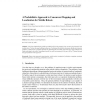Free Online Productivity Tools
i2Speak
i2Symbol
i2OCR
iTex2Img
iWeb2Print
iWeb2Shot
i2Type
iPdf2Split
iPdf2Merge
i2Bopomofo
i2Arabic
i2Style
i2Image
i2PDF
iLatex2Rtf
Sci2ools
AROBOTS
1998
1998
A Probabilistic Approach to Concurrent Mapping and Localization for Mobile Robots
This paper addresses the problem of building large-scale geometric maps of indoor environments with mobile robots. It poses the map building problem as a constrained, probabilistic maximum-likelihood estimation problem. It then devises a practical algorithm for generating the most likely map from data, along with the most likely path taken by the robot. Experimental results in cyclic environments of size up to 80 by 25 meter illustrate the appropriateness of the approach.
AROBOTS 1998 | Large-scale Geometric Maps | Map Building Problem | Maximum-likelihood Estimation Problem |
| Added | 21 Dec 2010 |
| Updated | 21 Dec 2010 |
| Type | Journal |
| Year | 1998 |
| Where | AROBOTS |
| Authors | Sebastian Thrun, Wolfram Burgard, Dieter Fox |
Comments (0)

